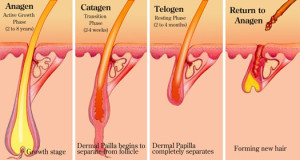Five Common Black Hair Growth Myths- Do you know of any more?
Black hair growth myths are so deeply entrenched that persons often find it impossible to believe that there is more to kinky/curly/coily hair than what they have been told their entire lives. I didn’t want to discuss this as yet in my blog series as I am still compiling articles on hair in general. However, recently, I was told something so unbelievably stupid about natural Afro-textured hair that I figured that I needed to publish this sooner. Today’s blog will be about myths about African hair. I will deal with the totally absurd things I’ve heard about African hair another time.
Myth #1: Black Hair Doesn’t Grow
This myth is pervasive because the length that a lot of black women covet has been seemingly out of reach for them. This has been mistakenly attributed to an inability for the hair itself to grow, never mind that persons have to relax or colour their NEW GROWTH every six weeks. The problem with black hair growth lies in the ease with which the hair breaks. LENGTH RETENTION is hard due to poor grooming practices i.e. daily flatiron or curl, abusive combing of the hair, and not conditioning the hair enough. Once those problems have been addressed, persons will be surprised as to how much hair will remain on their head and how much longer it will get.
Myth #2: Natural hair is tough and unmanageable
And why not? After all, a lot of persons have memories of their hair actually breaking combs! Telling someone in Jamaica that ,”Your hair favour coir*,” conjures up images of an unruly dry mass that is beyond salvation. This is so far from the truth. Experimental data have conclusively shown that African hair is the most fragile compared to other racial hair types. Each bend in the hair is a potential point for breakage. It is the innate dryness of the hair that causes significant friction making it difficult to comb. Studies also showed that wet combing the hair and using a leave-in-conditioner will make it much easier to comb and therefore manage.
Myth #3: Natural hair is thick, plentiful and STRONG
Do not be fooled by the illusion of 3-D volume created by curls. Persons are often surprised by the reduction in volume they see when they straighten their hair. The density of hair on anyone’s scalp is genetically determined. Blacks in general have the least amount of hair on their heads compared to other races. Only natural red heads have the lowest density compared to persons of African descent. Even the hair strands are not as thick as people think they are. Asians have the thickest strands, African hair is in the middle, while whites have finer hair.
It is the difficulty in combing natural hair that causes persons to assume the hair is strong. Heck, people think that the hair is so strong that it can stop the path of missiles! People, therefore, then do all sorts of crazy things like going platinum blonde in one sitting and then wonder why their hair breaks right down to their scalp simply because they thought their hair could take it? Studies have shown that African hair breaks at a lower applied force than European and Asian hair. It is not as hardy as it appears. Treat your hair delicately and it will thank you for it.
Myth #4: Wearing braids/weaves grows your hair
This is not entirely false. Wearing additional hair does decrease the amount of daily handling of the hair thus allowing the hair to retain length. However, too tight braiding that causes soreness to the scalp will result in hair pulled out directly from the root, and if the hair strand was weak and dry before braiding/weaving, the hair will dry out even more and break once the additional hair is installed. This is especially true if the type of hair used is ultra absorptive sucking all the oils and moisture away from your own strands of hair. So even though persons have experienced significant hair growth after having installed braids or weave, they still had to cut a lot of it off due to the poor condition the hair was found to be in. It is imperative that the hair is in excellent condition BEFORE installing the added hair. Ensure that you deep condition before installing, and continue to moisturise the hair under the wig, weave or braid extensions, otherwise the rest period would have been a wasted effort.
Myth #5 : Hair oils/pomades and “growth creams” will make your hair grow
For whatever reason, this myth cannot be banished to never neverland. There is always someone in the beauty supply store exclaiming how X product for their scalp grew their hair. Now there are some things that have been clinically proven to grow hair e.g. Minoxidil, however, not everything that is on the market has been definitively shown to grow hair. In any case, your hair will grow once you are properly nourished and are not experiencing some internal problem , such as Thyroid disease or Systemic Lupus, or some scalp disease such as Alopecia areata, Lichen Planopilaris or Traction Alopecia. Once you adopt a better hair care regimen, the length will be seen eventually.
*coir-fibre from the husk of the coconut mistakenly pronounced “kaya” in Jamaica.
About
Dr. Llorenia Muir-Green is a practising dermatologist in Jamaica. She has an avid interest in hair and scalp disorders. She is a member of the Medical Association of Jamaica, Dermatology Association of Jamaica and is an Associate Member of the Caribbean Dermatology Association. She was a recipient of the 2013 Fellowship in Hair and Scalp Disorders at the University of British Columbia.



